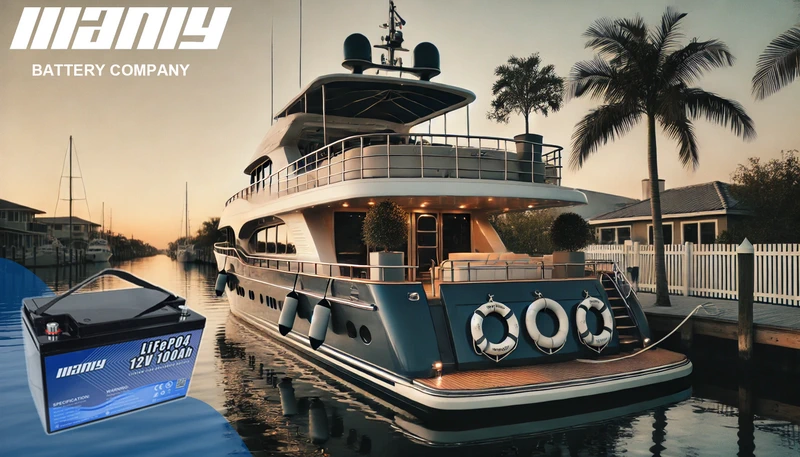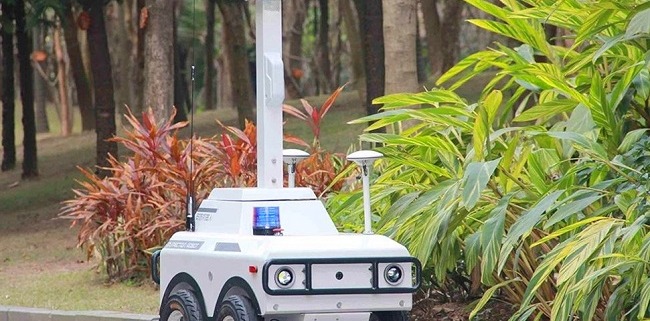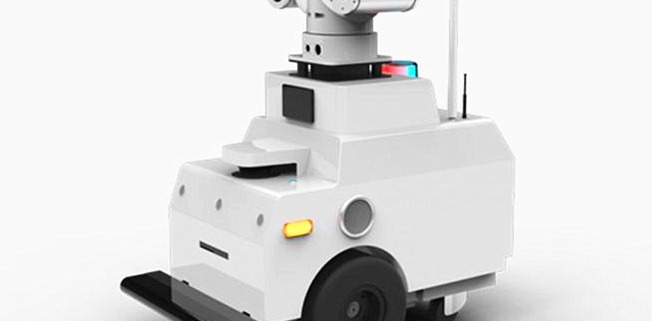What Type of Battery is a Marine Battery? A Detailed Breakdown
Table of Contents
- What Type of Battery is a Marine Battery? A Detailed Breakdown
- What is a Marine Battery?
- Different Types of Marine Batteries and Their Features
- The Best Choice: LiFePO4 Batteries for Marine Use
- Why LiFePO4 Batteries Are the Best Marine Batteries?
- Conclusion
- FAQ
- Hot Search
- 2024 UK Mother’s Day: Lifepo4 Battery, a Meaningful Gift
- In the future, security robots will show their talents
- The advantages and development trend of security robots
Maintaining a consistent and dependable boating experience depends on choosing the right marine battery. Whether you use a trolling motor, start your engine, or run electronics, the appropriate battery type will make all the difference. The several choices for batteries make many sailors find it difficult to choose the right one.
This article will break apart lead-acid, AGM, gel, and LiFePO4 batteries as well as other types of marine batteries. You will learn every type in great depth, including its benefits, drawbacks, and optimal uses. By the conclusion, you will understand the reason LiFePO4 batteries are the best fit for marine applications.
What is a Marine Battery?
Designed especially to withstand adverse sea conditions, a marine battery is Unlike automobile batteries, which only provide short bursts of electricity to start an engine, marine batteries must deliver constant power for lengthy durations while tolerating vibrations, dampness, and temperature variations.
- Usually driven by its intended use, marine batteries are categorized:
- The starting battery runs the boat motor. It gives a brief, sharp boost but lacks long-term vitality.
- Deep-cycle batteries run constantly for lights, fish finders, and trolling motors among other equipment.
- A dual-purpose battery sometimes performs worse than dedicated beginning and deep cycle batteries, even if it aims to combine two uses.
These classification indicate the use of a marine battery, although the most important factor influencing battery performance is battery chemistry. Chemistry of a battery determines its general performance, longevity, efficiency, and maintenance requirements.
Different Types of Marine Batteries and Their Features
The several kinds of marine batteries are listed below, together with their characteristics:
Lead-Acid Marine Batteries
Lead-acid batteries have been used in marine conditions as they have been rather competitively priced and widely available for decades. These batteries chemically react with lead plates and sulphuric acid to generate power.
Flooded Lead-Acid (FLA) Batteries
Flooded lead-acid batteries are the most classic form. They demand consistent maintenance, including topped off distilled water. They are heavy, require ventilation, have a shorter lifetime than other battery types even if they are economically priced.
Sealed Lead-Acid Batteries
Lead-acid batteries sealed eliminate maintenance needs and are spill-proof. Two most widely used variants that improve performance over typical flooded lead-acid batteries are AGM (absorbed glass mat) batteries and gel batteries.
Advantages of Lead-Acid Marine Batteries
Lead-acid batteries are reasonably cheap and rather numerous. Their great starting current makes them worth using for engine cranking.
Disadvantages of Lead-Acid Marine Batteries
Lead-acid batteries need regular maintenance, weigh a lot, and charge slowly. Usually running for two to four years, their lifetime is short; they break down upon discharge below 50% capacity.
AGM (Absorbed Glass Mat) Marine Batteries
AGM batteries are spill-proof and maintenance-free by absorbing the electrolyte using fiberglass mats, therefore improving traditional lead-acid designs.
How do AGM Batteries Work?
By immobilising the electrolyte inside the glass mat, AGM batteries reduce the possibility of leaking and hence maximise power efficiency. Since this structure lets for better resistance to vibrations and faster charging periods, AGM batteries are a more durable replacement for flooded lead-acid batteries.
Advantages of AGM Marine Batteries
Zero maintenance and faster charging than other lead-acid models describe AGM batteries. Their lifetime is between three and six years, and they have more resistance to deep discharges.
Disadvantages of AGM Marine Batteries
AGM batteries remain heavier than lithium alternatives even with their superior performance. On a tight budget, they also appeal less to boaters since they cost more than flooded lead-acid batteries.
Gel Marine Batteries
Gel batteries use liquid electrolytes from a silica-based gel. Less leaks and greater deep discharge performance are made possible by this chemical composition.
How do Gel Batteries Work?
The gel-based electrolyte lowers chemical reactions, therefore reducing the possibility of overcharging or deep discharge. Applications needing constant, long-term power will find ideal use for these batteries.
Advantages of Gel Marine Batteries
Gel batteries resist high temperatures, maintain a longer lifetime than flooded lead-acid batteries, and require no maintenance.
Disadvantages of Gel Marine Batteries
The slow charging rate of gel batteries is its biggest drawback. Furthermore expensive than AGM and flooded lead-acid batteries are they are. Less forgiving than other battery kinds, overcharging can damage a battery permanently.
The Best Choice: LiFePO4 Batteries for Marine Use
The most intelligent and powerful marine batteries are LiFePO4 (Lithium Iron Phosphate). Unlike lead-acid batteries, which rely on chemical interactions between lead and acid, they offer constant and dependable power by means of lithium-ion technology.
Why LiFePO4 Batteries are Superior?
Among their most important benefits are LiFePO4 batteries’ extended lifespan. Lead-acid batteries run two to six years; LiFePO4 batteries can run ten years or more. Since they weigh up to 70% less than lead-acid batteries and are more easily handled, they also greatly improve boat performance.
Charging time offers still another major advantage. Five times faster charging of LiFePO4 batteries than with lead-acid batteries Unlike lead-acid batteries, which have to be kept above 50% charge, they also enable total discharges free from battery damage.
Are There Any Drawbacks to LiFePO4 Batteries?
The sole negative of LiFePO4 batteries is their starting cost. For seasoned sailors, however, they are the most affordable choice because of their long lifetime, fast charge times, and low maintenance needs.
Why LiFePO4 Batteries Are the Best Marine Batteries?
LiFePO4 batteries have long-term benefits above all other battery models, even if their initial expense makes many sailors unwilling to switch. Boats carrying LiFePO4 batteries had 30% longer running lifetime on electronic systems and trolling motors, according a study by marine engineers.
Savings in weight also improve performance. LiFePO4 technology lets a boat greatly reduce the weight of its battery, therefore enhancing fuel economy and general maneuverability. Boaters looking for dependability, fast charging, and long-lasting performance would best invest in LiFePO4 batteries.
Conclusion
The perfect sailing voyage depends on selecting the right marine battery. Though lead-acid, AGM, and gel batteries are still somewhat popular, none give the efficiency, lifetime, and long-term savings LiFePO4 batteries offer.
LiFePO4 batteries from MANLY Battery provide the finest answer if you want a dependable and high-performance marine battery. Their innovative lithium technology guarantees exceptional energy economy, therefore assuring that your boat keeps running without the trouble of regular replacements.
For premium-quality marine batteries, visit MANLY Battery today and experience the next generation of marine power solutions.
FAQ
1. Is a deep cycle battery the same as a marine battery?
Let’s clarify: a deep cycle battery and a marine battery aren’t the same, although they have similarities. Here’s why:
A deep cycle battery provides a steady power flow over an extended period. It’s designed for applications that need consistent energy, like golf carts, RVs, or renewable energy systems. These batteries are built to handle repeated discharges and recharges without losing performance.
On the other hand, a marine battery is specifically made for boats. However, marine batteries come in two types: starting and deep cycle. A starting battery delivers a quick surge of power to start the engine, while a deep cycle marine battery powers your boat’s electronics and other devices.
So, while some marine batteries are deep cycle, not all deep cycle batteries work as marine batteries. If you’re choosing a battery for your boat, ensure it’s designed for marine use to get the most reliable power.
2. What are the three types of marine batteries?
Marine batteries come in three main types, each serving a different purpose. Understanding their roles helps you pick the right one for your boat:
- Starting Batteries: Starting batteries provide a quick burst of power to start your engine. They’re all about delivering a high-energy jolt for a short time. These batteries are not designed to power other devices, so they focus only on getting your engine running.
- Deep Cycle Batteries: Need power for your boat’s electronics, trolling motor, or other accessories? Deep cycle batteries are your answer. They deliver steady, long-lasting energy and can discharge and recharge multiple times without losing capacity. Perfect for extended trips or when you’re off the grid!
- Dual Purpose Batteries: As the name suggests, dual purpose batteries combine the functions of both starting and deep cycle batteries. They give you enough power to start your engine and supply energy to your accessories. They offer versatility but may not provide as much power as a dedicated starting or deep cycle battery.
Hot Search
Marine Lithium Battery Battery Manufacturer
Hello
With the progress of the times, intelligent products gradually appear in the public eye, and the robot industry has also begun to develop by leaps and bounds.
At present, under the upsurge of artificial intelligence, the traditional security inspection industry is facing huge challenges. Therefore, the security inspection industry has to undergo technology and model transformation, and security inspection robots also contain new market opportunities.
The security inspection robot is an unmanned inspection system based on 5G communication. It is a device that integrates technologies such as the Internet of Things, artificial intelligence, cloud computing, and sensors. As a subdivision of the special robot industry, the security inspection robot is mainly based on the actual needs of life, and is used to solve hidden safety hazards, patrol monitoring and disaster warning, so as to reduce the occurrence of safety accidents and reduce the loss of life and property.
Due to the advantages of security inspection robots, they are gradually applied to various special places to help people complete monitoring and security work.
Substation security inspection robot: It mainly adopts the respirator color recognition system, instrument detection system, infrared measurement system, etc. The integration of various technologies enables the security inspection robot to autonomously inspect indoor and outdoor high-voltage equipment, and can give early warnings and find inspections. Equipment failure and other problems, provide operators with detection data, maintain the normal operation of equipment, and provide safety guarantees for relevant staff.
Disaster prevention and security inspection robot: It is mainly used to detect agricultural and forestry geological conditions. Through control devices, identification systems, transmission methods, etc., it can conduct security detection on various terrains such as mountains and steep slopes, realize data collection, and finally form a Complete monitoring system.
Daily security inspection robot: It is mainly used at the gate of the community or at various entrances and exits, and can also be used as a security guard. It integrates high-definition cameras, infrared thermal imaging, environmental sensors, and warning light devices. It can perform tasks autonomously, 24-hour all-round audio and video monitoring, and automatic alarms for abnormal situations. Therefore, it saves a certain amount of labor costs.
In addition to the common technologies of mobile robots, security inspection robots also need navigation and positioning, computer vision, movement and motion control, target detection and recognition, sensors, human-computer interaction and other related technologies under the factors of security application goals and environment. support. Among them, navigation and positioning technology is the most basic technical requirement of security inspection robots. Therefore, researchers are required to provide the best navigation for security inspection robots according to different application scenarios, combined with environmental characteristics, navigation accuracy, implementation cost and reliability. positioning scheme.
The security inspection robot market is a market with great potential, and it is also an industry with a lot of accumulation. Its development direction is mainly focused on image and video accurate recognition, big data mining, intelligent early warning and other aspects. How to seize the opportunity and how to develop and evolve have become key issues. Overall, the future development prospects of security inspection robots are worth looking forward to.
Robot technology has always been a research field that humans attach great importance to. As the technology with the most research and development value in the future, it will be widely used in various high-tech industries. In recent years, robots have become more and more intelligent, and the reason is due to the development of a series of emerging technologies, mainly including cloud computing, artificial intelligence, big data, computer vision, etc. In particular, the rapid development of artificial intelligence has enabled robots to have higher intelligence and can replace humans to undertake more and more important tasks
According to statistics, in the security group, security personnel over 40 years old are as high as 55%. As a result, the security industry is in an unstable state. At the same time, the existing products in the security industry have certain problems. One is that there are many types, but single functions and lack of flexibility; secondly, the existing security products cannot intelligently process monitoring information and require manual processing. In addition, a large number of security personnel are required, and the timeliness of information processing may be affected by other factors. With the rapid development of information technology and the rapid growth of the real estate industry, the concept of smart city has emerged spontaneously, and security robots have quietly emerged as a complex of comprehensive artificial intelligence, automatic control and other technologies.
The security robot will be based on the mobile control platform, on which the navigation system, inspection system, vision processing technology, feature recognition, positioning technology and other technologies will be built. Compared with the previous security system, the security robot has the following advantages:
24/7 autonomous patrol. In the automatic patrol mode, the robot does not need too much human intervention. The robot will control the movement of the mobile platform according to its own navigation system and positioning system. At the same time, multiple robots can be used in the patrol area to form a patrol network without dead ends, so that even if one robot is automatically charging, other robots can automatically patrol, which makes the security work more stringent.
Intelligent analysis and alarm. Security robots can be equipped with various sensors: cameras, temperature sensors, gas sensors, temperature sensors, and more. Using sensor information, combined with computer vision, speech recognition, sensors and other technologies to monitor the surrounding environment in real time. When the robot finds a suspected abnormality through pedestrian identification, smoke detection, temperature detection, etc., it can actively turn on its own alarm device, and notify the corresponding security personnel through the Internet and other means.
Compared with humans, robots can continue security patrol work in relatively harsh environments, such as strong winds, heavy rains, cold, and high temperatures.







